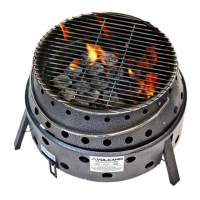10
Tear Down/Clean for Wood/Charcoal cont
Storage
Maintenance
• Clean out cooking chamber
with mild detergent and
soft cloth.
• Do not use abrasives.
• Disconnect regulator from cylinder. If stored indoors, detach and
leave cylinder outdoors.
• Store propane tank in safe manner. Follow all local Storage and
Handling of Liqueed Gases codes. Always store propane tanks
outdoors.
• Store stove in a dry, clean and safe place.
• Place the cleaned top grill, bottom grill, diffuser plate, burner cra-
dle and REGULATOR into the Volcano storage bag for storage.
• For long-term storage, clean and dry all stove parts before stor-
ing. This will keep the unit clean and ready for the next season.
• Place the stove in the Volcano storage bag and zip shut.
To enjoy years of outstanding performance from your stove, perform
the following maintenance activities on a regular basis:
• Keep exterior surfaces clean.
• Use warm soapy water for cleaning. Never use ammable or abra-
sive cleaning agents.
• Airow must be unobstructed. Keep controls, burner and circulat-
ing air passages clean. Signs of possible blockage include:
-Gas odor
-Stove makes popping noises
-Smoky ame.
• Spiders and insects can nest in burner orices. This condition
can damage the stove and render it unsafe for use. Clean burner
holes by using a heavy-duty pipe cleaner. Compressed air may
help clear away small particles. See page 9 for more detailed
instructions.
• Carbon deposits may create a re hazard. Clean burner with
warm soapy water if any carbon deposits develop.
WARNING
BURN HAZARD
• Do not touch or attempt any maintenance on stove for at least
one hour after use.
• Make sure all controls are off and propane tank has been re-
moved before doing maintenance.
Prior to lighting, position thermometer clip so that at least 1/2:” of ther-
mometer tip is submerged in oil. Reposition thermometer as necessary
to cook. Continue to use thermometer until burner is turned off.
IF FRYING:
• Follow instructions provided by the appliance manufacturer.
• When cooking with oil or grease, a thermometer must be used.
• Introduction of water from any source into the cooking oil or grease
may cause overow and severe burns from hot oil and water splat-
ter. When frying with oil and grease, all food products MUST be
completely thawed and towel dried to remove water before being
immersed in the fryer.
• Be sure thermometer is in good working condition. To check the
thermometer, insert it into a pot of boiling water and ensuring that it
register approximately 212°F ± 20°F (100°C ± 10°C). If it does not
function properly, obtain a replacement thermometer specied by the
manufacturer before using the appliance.
• When frying with oil or grease, do not use a pot deeper than 6”
(132mm).
• Do not over ll the pot with cooking liquid. Never ll appliance more
than half full of cooking liquid or past the maximum ll line (a perma-
nent marking on fryer).
• If cooking liquid has spilled and ignited, do not attempt to extinguish
with water. Immediately turn gas supply OFF at the supply cylinder
and:
o Extinguish ames using a BC type re extinguisher as
recommended by the fryer manufacturer; or
o Smother ames with dirt or sand.
o In case there is a re, call the local re department or dial
911.
o To avoid accidental burns from burner ame or hot cooking
liquid, turn the burner off before inserting or removing food
from the fryer.
o When removing food from the fryer, be sure to avoid burns
from hot cooking liquid drippings.
• If the stove has been left uncovered and is wet from rain, snow, yard
sprinklers, etc., allow to dry (at least 30 minutes prior to use).
• Keep appliance area clear and free from combustible materials,
gasoline and other ammable vapors and liquids.
• NOTE: In a salt-air environment (such as near an ocean), corrosion
occurs more quickly than normal. Frequently check for corroded
areas and repair them promptly.
Using a Thermometer
WARNING
This appliance is not for frying turkeys.

